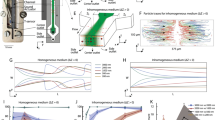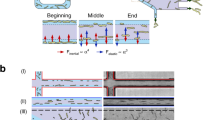Abstract
Cells aggregate and can be recovered from suspension when exposed to an ultrasonic standing wave field. The acoustic force on individual cells in a standing wave decreases with particle volume. A plane ultrasonic field generated by a transducer driven at 3.3 MHz was used here to investigate the removal of Escherischia coli, cells with dimensions of the order of 1.0 μm, from batch suspension by sedimentation over a range of concentrations (103 to 1010 cells ml−1). Cell removal efficiencies greater than 90% were achieved at initial concentrations of 1010 cells ml−1. Removal efficiencies decreased gradually to zero, as initial bacterial concentration was reduced to 107 cells ml−1. It was found that, when low concentrations of E. coli (103 to 105 cells ml−1) were added to suspensions of larger particles (i.e. yeast cells) that were of sufficient concentration to form aggregates in the sound field, E. coli could be harvested to an efficiency of 40%. The results imply that the E. coli became trapped and sediment with aggregates of larger particles. Some strains of bacteria are capable of DNA transfer by conjugation. The transfer rate of E. coli RP4 plasmid is order of magnitudes greater when conjugation occurs on solid medium rather than in liquid suspension. We have investigated whether the conjugation rate would also be higher in ultrasonically induced E. coli clumps than in free suspension. The donor strain was mixed with a recipient strain of E. coli, then sonicated in a capillary at 4.6 MHz in a tubular transducer for 5 min. The bacteria aggregated successfully. Results showed a three-fold increase in the rate of conjugation compared to a liquid mating control.
Similar content being viewed by others
References
Andrup L and Andersen K (1999) A comparison of the kinetics of plasmid transfer in the conjugation systems encoded by the F plasmid from Escherichia coli and plasmid pCF10 from Enterococcus faecalis. Microbiology 145: 2001-2009.
Bradley DE (1983) Specification of the conjugative pili and surface mating systems of Pseudomonas plasmids. J. Gen. Micro. 129: 2545-2556.
Coakley WT (1997) Ultrasonic separations in analytical biotechnology. Trends Biotechnol. 15: 506-511
Coakley WT, Whitworth G, Grundy MA, Gould RK and Allman R (1994) Ultrasound manipulation of particles and cells. Bioseparation. 4: 73-83.
Cullum J, Collins JF and Broda P (1978) Factors affecting the kinetics of Progeny formation with F'lac in Escherichia coli K12. Plasmid 1: 536-544.
Gray SJ, Sobanski MA, Kaczmarski EB, Guiver M, Marsh WJ, Borrow R, Barnes RA and Coakley WT (1999) Ultrasound-enhanced latex agglutination and PCR as complementary methods for non-culture-based confirmation of meningococcal disease. J. Clin. Microbiol. 37: 1797-1801.
Gröschl M (1998) Ultrasonic separation of suspended particles — Part I: Fundamentals. Acustica 84: 432-447.
Grundy MA, Bolek WE, Coakley WT and Benes E (1993) Rapid agglutination testing in an ultrasonic standing wave. J. Immunol. Methods 165: 47-57.
Hawkes JJ, Limaye MS and Coakley WT (1997) Filtration of bacteria and yeast by ultrasound-enhanced sedimentation. J. Appl. Micro. 82: 39-47.
Hawkes JJ, Barrow D, Cefai J and Coakley WT (1998) A laminar flow expansion chamber facilitating downstream manipulation of particles concentrated using an ultrasonic standing wave. Ultrasonics 36: 901-903.
Levin BR, Stewart FM and Rice VA (1978) The kinetics of conjugative plasmid transmission: Fit of a simple mass action model. Plasmid 2: 247-260.
Limaye MS and Coakley WT (1998) Clarification of small volume microbial suspensions in an ultrasonic standing wave. J. Appl. Micro. 84: 1035-1042.
Madigan MT, Martinko JM and Parker J (1997) Brock's Biology of Microorganisms, 8th editon. Prentice Hall, Upper Saddle River, New Jersey.
Miles AA and Misra CC (1938) The estimation of the bactericidal power of the blood. J. Hyg. Camb. 38: 732.
Miles CA, Morley MJ, Hudson WR and Mackey BM (1995) Principles of separating microorganisms from suspension using ultrasound. J. Appl. Bact. 78: 47-54.
Nyborg WL (1965) Acoustic streaming. In: Mason WP (ed.) Physical Acoustics 2, Part B. (pp. 265-331). Academic Press, New York.
Paranchych W and Frost LS (1988) The physiology and biochemistry of pili. Adv. Microb. Physiol. 29: 53-114.
Perkins CD, Davidson AM, Day MJ and Fry JC (1994) Retrotransfer kinetics of R300B by pQKH6, a conjugative plasmid from river epilithon. FEMS Microbiol. Ecol. 15: 33-44.
Spengler J and Jekel M (2000) Ultrasound conditioning of suspensions — studies of streaming influence on particle aggregation on a lab-and pilot-plant scale. Ultrasonics 38: 624-628.
Silverman PM (1997) Towards a structural biology of bacterial conjugation. Mol. Microbiol. 23(3): 423-429.
Weiser MAH and Apfel RE (1982) Extension of acoustic levitation to include the study of micron-size particles in a more compressible fluid. J. Acoust. Soc. Am. 71: 1261-1268.
Willets N and Skurray R (1980) The conjugative system of F-like plasmids. Annual Review of Genetics 14: 41-76.
Woodside SM, Piret JM, Gröschl M, Benes E and Bowen BD (1998) Acoustic force distribution in resonators for ultrasonic particle separation. AICHE J. 44(9): 1976-1984.
Author information
Authors and Affiliations
Rights and permissions
About this article
Cite this article
Cousins, C.M., Melin, J.R., Albert Venables, W. et al. Investigation of enhancement of two processes, sedimentation and conjugation, when bacteria are concentrated in ultrasonic standing waves. Bioseparation 9, 343–349 (2000). https://doi.org/10.1023/A:1011181431742
Issue Date:
DOI: https://doi.org/10.1023/A:1011181431742




